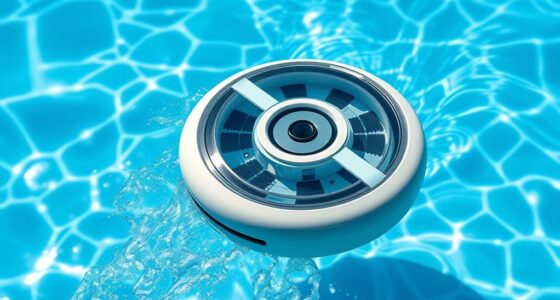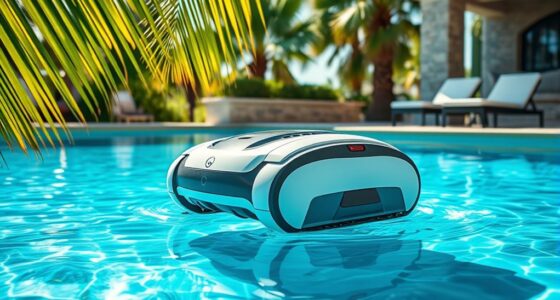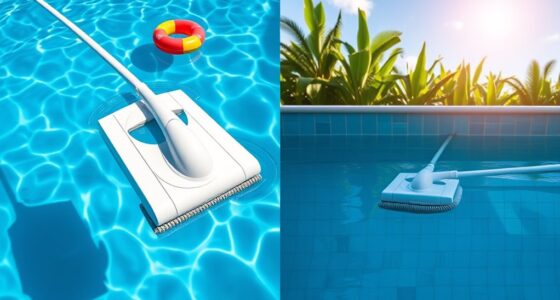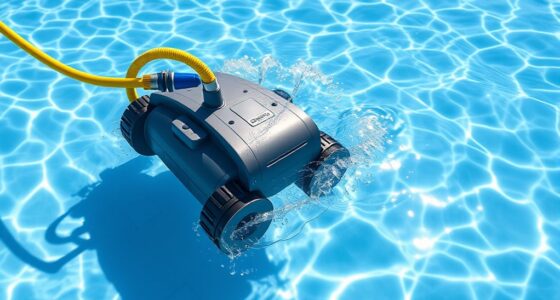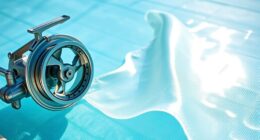To begin a chlorine wash on your swimming pool, start by draining it to get rid of any algae and bacteria. Apply diluted liquid chlorine evenly, then scrub the pool surface thoroughly. Rinse carefully to remove any remaining contaminants. Be sure to properly dispose of the wastewater. Use a water testing kit before refilling the pool to check the chemical levels. Keep balanced water levels and cleanliness for safety. Consider scheduling the wash during colder months and seek professional help if needed for optimal results. Stay diligent in monitoring and maintaining water quality to ensure a safe and clean pool. Additional steps can help enhance your chlorine wash process.
Key Takeaways
- Drain pool to remove algae and bacteria.
- Apply diluted liquid chlorine evenly.
- Scrub pool surface with a brush.
- Rinse pool thoroughly after treatment.
- Dispose of wastewater properly.
Draining the Pool
To begin the chlorine wash process, drain your swimming pool using a submersible pump. This step is important to remove any algae or bacteria buildup present in the pool. Utilizing a submersible pump guarantees an efficient draining process, typically taking about a day to complete.
However, it's essential to adhere to disposal regulations when dealing with the drained water. Local regulations may dictate proper disposal methods, which could include directing the drained water to a designated area or following specific guidelines for disposal.
By draining the pool, you create a clean slate for the subsequent chlorine washing process, enabling thorough cleaning of the pool surfaces. Once the pool is drained, you can proceed with applying the chlorine wash to effectively sanitize the pool and ensure a safe swimming environment.
Remember to always follow local regulations for the proper disposal of the drained water to maintain environmental safety and compliance.
Applying Liquid Chlorine
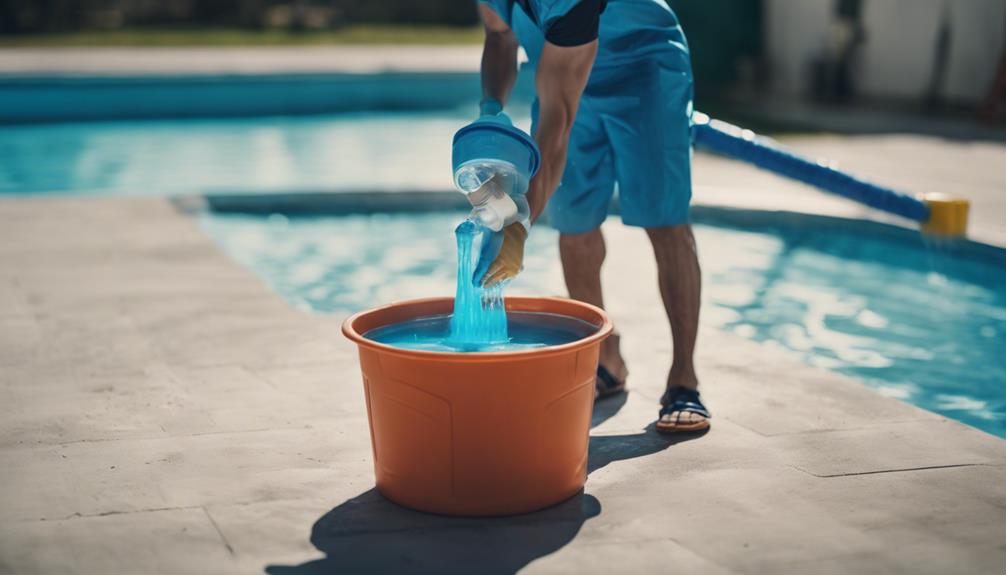
Consider diluting liquid chlorine with water in a container before evenly applying it to your pool surfaces for a thorough cleaning process. Liquid chlorine is an essential component for deep cleaning your pool and effectively combating algae and bacteria.
Quality liquid chlorine can be easily obtained from home and garden stores, ensuring your pool maintenance is hassle-free. When applying the liquid chlorine washes, make sure to coat the pool sides and bottom evenly with the solution. This thorough application is vital for ensuring a detailed cleaning process.
By targeting all pool surfaces, you can effectively eliminate algae and bacteria, promoting a cleaner and safer swimming environment. Remember, liquid chlorine is a powerful tool in your pool maintenance routine, but always follow manufacturer instructions for safe and effective use.
After application, scrubbing away any remaining algae on the pool surfaces will further enhance the cleanliness of your pool.
Scrubbing the Pool Surface

In order to effectively scrub your pool surface, it's crucial to use a bristled brush that can tackle algae and contaminants. Make sure to scrub in a back and forth motion, covering all areas thoroughly.
Focus on spots with visible algae or staining for a more meticulous cleaning process.
Surface Preparation Tips
Begin scrubbing the pool surface with a bristled brush to effectively remove algae and contaminants. Utilize a circular motion while scrubbing to guarantee thorough coverage and efficient algae removal.
Pay close attention to areas where algae growth is visible, especially focusing on corners and crevices where contaminants tend to accumulate. After scrubbing, remember to rinse the pool surface to eliminate loosened algae and debris, promoting a cleaner finish.
If needed, repeat the scrubbing process to secure a pristine and algae-free pool surface. By following these surface preparation tips diligently, you can make sure that your chlorine wash pool treatment is successful in maintaining a hygienic swimming environment.
Prioritizing thorough scrubbing and attention to detail will help you achieve excellent results in preparing your pool surface for the chlorine wash treatment.
Choosing Right Scrubber
For a thorough cleaning, make sure to select either a nylon or stainless steel brush when scrubbing your pool surface to ensure complete algae removal. When choosing the right scrubber, consider the material of your pool surface to prevent any damage.
Nylon brushes are gentle and suitable for most pool surfaces, while stainless steel brushes are more abrasive and ideal for tough stains that require a deeper clean. Regularly cleaning and rinsing the scrubber after each use is crucial to maintain its effectiveness.
Additionally, using a brush with an extension pole will make it easier to reach all areas of the pool surface, ensuring a thorough scrubbing process.
Proper Scrubbing Technique
Start scrubbing the pool surface with a stiff bristled brush to thoroughly remove algae and dirt, applying pressure as needed to dislodge any buildup. Focus on areas where algae growth is visible, guaranteeing a thorough cleaning.
Work methodically in small sections to avoid missing any spots and to ensure a thorough scrubbing. Applying pressure while scrubbing helps dislodge algae and dirt from the pool walls and floor, effectively removing any buildup.
After scrubbing, rinse the pool surface to eliminate loosened algae and debris, maintaining cleanliness. If necessary, repeat the scrubbing process to achieve a pristine, algae-free pool surface.
Rinsing the Pool

When rinsing your pool after applying chlorine, it's important to drain the pool water properly and thoroughly rinse all pool surfaces. This process helps remove any remaining algae or contaminants, ensuring a thorough and thorough cleaning process for a clean and safe swimming environment.
Make sure to pay attention to all areas of the pool, including walls, floor, and steps, for a detailed cleaning process.
Drain Pool Water
Utilize a submersible pump to efficiently and safely empty the pool water for the chlorine wash process. Before beginning, it's important to check local regulations regarding pool water disposal to guarantee compliance.
The draining process may take up to a day, so plan accordingly. Make certain that the pool is completely emptied before moving forward with the chlorine wash.
Once the pool is drained, it's essential to rinse it thoroughly to prepare for the chlorine wash. This step helps remove any remaining debris or contaminants, ensuring that the chlorine treatment is effective.
Remember to follow the manufacturer's instructions for the submersible pump to operate it correctly and avoid any mishaps during the draining process.
Rinse Pool Surfaces
Thoroughly rinse the pool surfaces after scrubbing to eliminate any remaining algae or debris. Use a hose or pressure washer to make sure that all traces of chlorine residue are washed away from the pool, helping to maintain a safe swimming environment.
Pay close attention to corners, steps, and crevices during the rinsing process to prevent algae regrowth in these hard-to-reach areas. It's essential to remove any cleaning chemicals completely from the pool before refilling it with fresh water.
This step is vital for keeping the pool water clean and clear, guaranteeing a pleasant swimming experience for you and your guests. By taking the time to rinse the pool surfaces thoroughly, you're contributing to the overall cleanliness and hygiene of the pool, making it a more enjoyable space for relaxation and recreation.
Pumping Out Wastewater

To efficiently remove the wastewater from your pool after the chlorine wash, use a submersible pump. This pump is designed to effectively eliminate the chlorine-water-algae mixture that settles at the pool's bottom post-wash.
Proper disposal of this wastewater is vital to prevent environmental contamination. It's important to adhere to drainage regulations and avoid draining the wastewater into storm drains or natural water bodies. Disposing of the wastewater in these locations can harm aquatic life and pollute the environment.
When pumping out the wastewater, consider the impact on the environment and choose disposal methods that minimize harm. Remember that refilling your pool with fresh water post-wastewater removal may take a day or two, depending on the pool's size.
Refilling the Pool
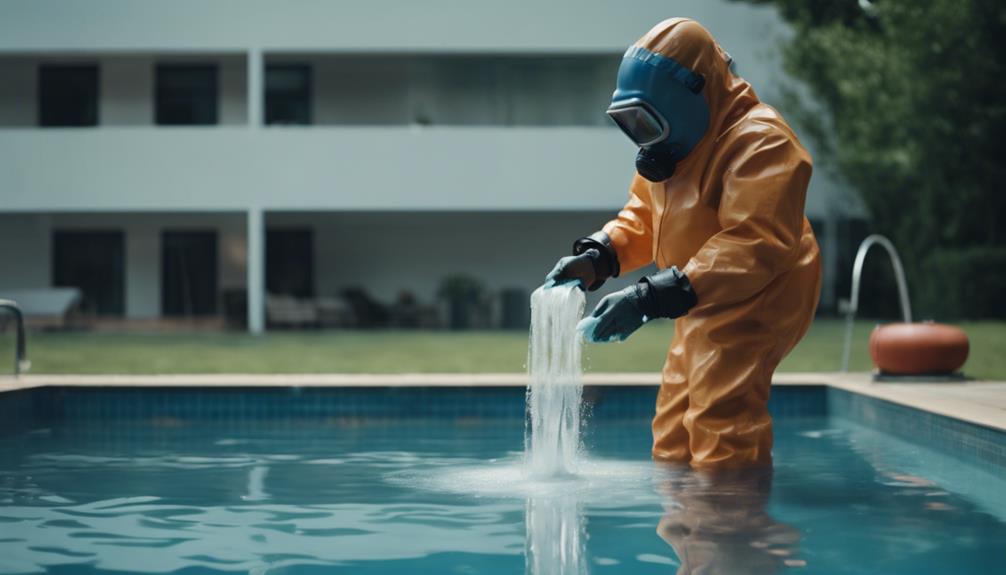
When refilling your pool post-chlorine wash, the process typically takes a day or two, depending on the pool's size and your water source. To guarantee the water quality meets standards, consider the following:
- Use a water testing kit to check the chemical balance levels of the refilled water.
- Employ a submersible pump to expedite the refilling process efficiently.
- Monitor the water level during refilling to prevent overflow or under-filling.
- Verify the water meets discharge regulations and environmental standards.
- After refilling, test for ideal pH, chlorine, and alkalinity levels to maintain water quality.
Maintaining proper chemical balance levels is essential for the health and safety of swimmers.
By following these steps and monitoring the refilling process carefully, you can make sure that your pool is ready for use with clean and balanced water.
Timing and Maintenance Considerations

Consider scheduling your chlorine wash during the colder months to minimize potential damage to the pool surface. Before initiating the process, make certain that the alkalinity levels are within the recommended range to guarantee the effectiveness of the chlorine washing.
Maintain balanced water levels to optimize the results of the treatment and prevent future issues. Regularly clean your pool pump and filter to avoid algae growth and maintain a clear pool. Using pool test strips can help you monitor the chemical balance accurately.
If needed, draining your pool before the chlorine wash may be necessary to achieve the best results. Remember that seeking assistance from a professional pool service can ensure a thorough and cost-effective chlorine wash for your pool.
Frequently Asked Questions
How Much Does It Cost to Chlorine Wash a Pool?
Chlorine washing a pool typically costs between $300 to $600, influenced by factors like pool size, algae severity, and location.
Additional expenses may include chemicals, equipment, and professional labor.
DIY options can be cost-effective, but hiring a professional guarantees thorough cleaning.
Regular maintenance and preventive measures can help reduce the frequency of chlorine washes, ultimately saving you money in the long run.
How to Dilute Pool Chlorine for Cleaning?
To dilute pool chlorine for cleaning, start by mixing equal parts of chlorine and water in a separate container. It's essential to follow recommended ratios to guarantee effective cleaning.
Adjust the concentration based on the severity of algae and your pool's size. Thoroughly mix the solution before applying it to the pool surfaces.
How to Properly Chlorinate a Pool?
To properly chlorinate a pool, follow these steps:
- Start by testing the water to determine the current chlorine levels.
- Next, add the appropriate amount of chlorine to achieve the recommended levels.
- Distribute the chlorine evenly across the pool surface and allow it to circulate for effective disinfection.
- Regularly monitor and adjust chlorine levels to maintain a safe and clean swimming environment.
How Much Chlorine to Clean a Pool?
To effectively clean a pool, the amount of chlorine required varies based on factors such as size, condition, and water volume. A general rule is to use 1 gallon of liquid chlorine for every 10,000 gallons of water for a thorough cleaning.
For pools with heavy algae growth, higher chlorine concentrations may be needed. Following manufacturer guidelines and regular testing of chlorine levels are essential to maintain a safe swimming environment and prevent damage.
What Are the Steps for Performing a Chlorine Wash on a Swimming Pool?
To perform a chlorine wash on a swimming pool, first, empty the pool and remove any debris. Next, mix the chlorine solution with water and apply it to the pool’s surfaces. Allow the solution to sit for several hours before thoroughly rinsing and refilling the pool. Regular maintenance is crucial to perform a chlorine wash.
Conclusion
To guarantee a chlorine wash on your swimming pool is a necessary step in maintaining clean and safe water for swimming. By following the outlined steps of draining, applying liquid chlorine, scrubbing, rinsing, pumping out wastewater, and refilling the pool, you can confirm that your pool is properly sanitized.
Remember to take into account timing and regular maintenance to keep your pool in top condition. Keep your pool sparkling and inviting with a thorough chlorine wash.



